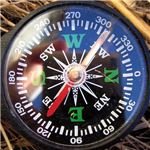All compass
needles when freely suspended point North. So what is special about a
magnetic compass at sea? Well, for one, great accuracy is required,
which means that all errors have to be accounted for. Read on to see how
this is done.

The Principles of the compass
A
Magnetic compass is a critical piece of marine navigational equipment.
Simply put, a magnetised needle, suspended freely, points North because
of the forces caused by the Earth’s magnetic field. Once North is known,
the other directions are easily found. You can see the adjoining image
to have a clearer idea.
The
ship magnetic compass is usually housed on the ‘monkey island’ above
the navigating bridge and reflected into the bridge by means of a
periscope like device, so a helmsman can easily read the compass when he
is steering the ship.
The Meridians, Two Definitions
The true meridian is the longitude and always points True North
The
Magnetic Meridian is at an angle to the True Meridian. Since the
Magnetic North and South poles of the Earth are not the same. It can be
imagined as ‘magnetic longitude’.
Why do we need great compass accuracy at sea?
The
marine magnetic compass at sea is mainly used for steering a course.
The compass reading must be accurate, especially on long sea passages,
because a error of one or two degrees in a long course can make a
difference of thousands of nautical miles in reaching your destination after many days.
The compass is also used to take bearings (see article on celestial navigation)
of terrestrial and celestial objects for navigation, and errors must be
minimised for this purpose. The compass reading at sea must be
therefore corrected as accurately as possible.
Errors and corrections in ship magnetic compass
Variation: Is
the angle between the true and magnetic meridian, that is to say, the
angle that the freely suspended magnetic needle makes with the True
Meridian. If the magnetic needle is drawn to the right of the true
meridian, the variation is termed Easterly and if the needle is drawn to
the left of the True Meridian, the variation is termed Westerly.
Variation differs from place to place but does not change with the direction of the ship’s head (course of the ship)
Deviation: A ship is made of steel,
acquires a certain magnetism and so inherently has an effect on the
magnetic compass. In other words, the compass needle on board does not
lie on the magnetic meridian but is deflected on one side or the other
because of the ship’s magnetism. Although corrective magnets are
inserted in the housing (also called binnacle) of the compass to
counteract this, the system is not perfect because the ship also loads
steel cargo which makes the error variable. Also, the error thus caused
is found to vary as the ship points in different directions (different
headings). This error is called ‘deviation’ and is named East if the
compass needle is drawn to the right and West if the needle is drawn to
the left.
Compass error is,
simply, the combination of the errors of Variation and Deviation, and
is applied by the navigator to the compass reading to get the corrected
compass reading.
Practice at sea
Variation is known for all geographical locations and is available to the mariner on charts.
Deviation is calculated every watch (every 4 hours) at sea by one of
many methods usually involving celestial bodies like planets and stars.
And so, the compass error at any point of time is accurately known.
By Manu

No comments:
Post a Comment